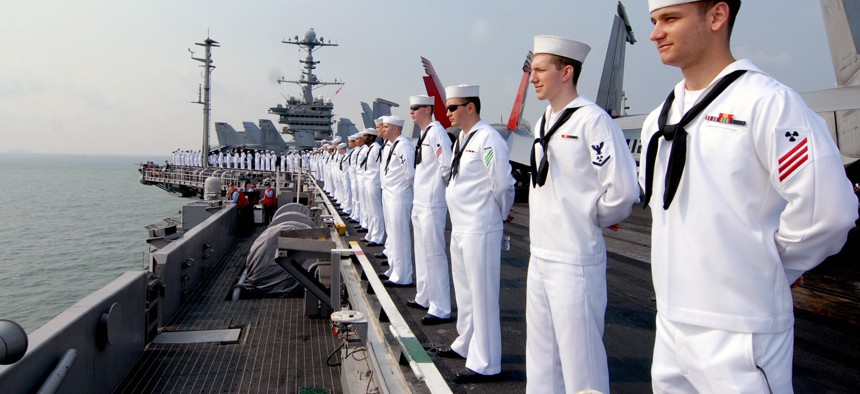Navy cyber director amps use of AI and computer automation
The Navy’s Digital Warfare Office is turning to AI for cyber defense.
The Navy is accelerating the use of artificial intelligence (AI) analytics for its Digital Warfare Office that is tasked with tracking and thwarting a wide range of cyberattacks.
“We see that the more we automate our networks and the more we use machines to do the heavy lifting, the better. Our brains do not have the intellectual capacity to process all of that information. This is imperative for how we will need to maneuver networks in the future,” Rear Adm. Danelle Barrett, Navy Cyber Security Division Director, told Defense Systems in an interview.
Barrett detailed the many benefits of AI for cyber defense, but also emphasized that AI can be extremely effective in offensive cyber operations. She did not want to elaborate on this, but she did say that computer automation can both track potential intruders and use advanced algorithms to replicate human behavior online by using deception techniques to lure and then track attackers.
Describing rapid technical advances in terms of human-machine interface, Barrett emphasized that AI will be fundamental to countering increasingly agile, creative and advanced enemy cyberattacks.
“Industry is using AI well and we want to be able to leverage those same capabilities, not just when it comes to defensive sensing of our networks but also to implement countermeasures. We are going to need AI to help us sort through threats,” Barrett explained.
Alongside some of the more technically advanced computer tactics, simple procedures – such as improved cyber hygiene – can be effective against cyberattacks.
Basic moves such as establishing multiple factors of authentication and controlling the number of people who have administrator privileges can also increase security, many officials have explained.
Part of the current interest in AI is grounded in an aggressive Navy effort to implement findings from a specific Task Force Cyber Awakening effort completed in 2015. Barrett said that millions in funding was reallocated toward improving cyber defense as a result of that work.
Task Force Cyber Awakening was a special Navy unit designed to address the extent to which networks and weapons systems are increasingly computer reliant, and therefore potentially more vulnerable.
Emerging from the work of the task force, Navy engineers, software developers and computer experts have been collaborating on ways to implement a series of new cyber hardening procedures.
“Our efforts are not only related to IT systems or command and control, but really extend to what we would consider as a control system on a ship. We look at the whole network, like a system on a ship, aircraft or submarine. We need to allow the Navy to protect a platform and identify anomalous behavior – and then restore networks. This is integral to our ability to fight and win in a conflict,” Barrett said.
Fire-control systems that track targets and launch missiles, manned-unmanned teaming between fighter jets and drones, algorithms for F-35 sensor fusion or mini-swarms of integrated drones designed to overwhelm enemy air defenses are all examples of larger weapons systems and platforms increasingly reliant upon computer systems.
Rapidly evolving cyber technology continues to expand well beyond computer networks, data systems and other IT military tasks to further integrate with weapons, ships, submarines and aircraft.
The Navy’s new Ford-class aircraft carriers are engineered with much greater quantities of computer automation designed to perform a wide range of ship functions traditionally performed by sailors. Navy acquisition leaders consistently emphasize that these innovations enable a carrier to operate with as many as 900 fewer sailors and results in savings of $4 billion over the life of a carrier.
Furthermore, ISR networks and weapons are improving their networked connectivity with faster digital processers able to shorten sensor-shooter targeting loops and improve electromagnetic warfare signals.
Combating computer viruses is an integral dimension to the overall approach, as well. Viruses often have an ability to spread through multiple computer systems and often begin with a questionable attachment of some kind. This can infect data and then spread to other systems, Navy experts explained.
While much progress is currently taking place, positioning requirements and the proper architecture for the future will likely be both necessary and challenging, the said.
Barrett emphasized that cyber defense progress is highly contingent upon the need to engineer emerging systems with open architecture.
It is important to build systems with standards and protocols into platforms so they can rapidly integrate software and hardware upgrades and adjust to new threats as they emerge, she explained.
Overall, Barrett said service engineers are working to quickly implement AI technologies and greater automation across a wide swatch of networks, systems and large platforms.
“We keep a keen eye on what is going on in academia and in the other services,” Barrett said.




